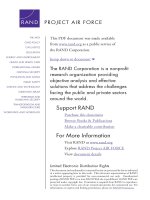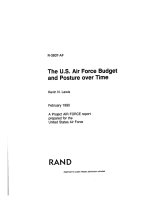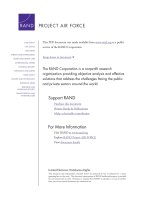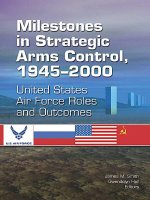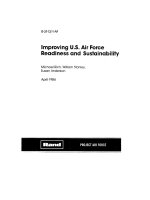Milestones In Strategic Arms Control, 1945-2000united States Air Force Roles And Outcomes ppt
Bạn đang xem bản rút gọn của tài liệu. Xem và tải ngay bản đầy đủ của tài liệu tại đây (757.38 KB, 318 trang )
US AIR FORCE INSTITUTE FOR NATIONAL
SECURITY STUDIES
US AIR FORCE ACADEMY
Milestones in Strategic Arms
Control, 1945–2000
United States Air Force
Roles and Outcomes
JAMES
M. SMITH
GWENDOLYN HALL
Editors
Air University Press
Maxwell Air Force Base, Alabama 36112-6615
in coordination with
USAF Institute for National Security Studies
USAF Academy, Colorado 80840
September 2002
Disclaimer
Opinions, conclusions, and recommendations expressed or implied within are solely those of
the contributors and do not necessarily represent the views of Air University, the United States
Air Force, the Department of Defense, or any other US government agency. Cleared for public
release: distribution unlimited.
Air University Press
131 West Shumacher Avenue
Maxwell AFB AL 36112-6615
ii
Air University Library Cataloging Data
Milestones in strategic arms control, 1945-2000 : United States Air Force roles and
outcomes /edited by James M. Smith and Gwendolyn Hall.
p. cm.
Includes bibliographical references.
Contents: Foundations for strategic arms control, 1945–1968 Strategic arms
limitations, 1969–1980 The Reagan years, 1981–1988 Strategic arms reductions,
1989–2000.
ISBN 1-58566-110-4
1.Nuclear arms control United States History. 2. Nuclear arms control
United States. 3. United States. Air Force History. I. Smith, James M., 1948- II.
Hall, Gwendolyn M. III. USAF Institute for National Security Studies.
327.1747 dc21
Contents
Chapter Page
DISCLAIMER . . . . . . . . . . . . . . . . . . . . . . . . ii
FOREWORD . . . . . . . . . . . . . . . . . . . . . . . . . vii
INTRODUCTION . . . . . . . . . . . . . . . . . . . . . . xi
PART I
Foundations for Strategic
Arms Control, 1945–68
1 The United States Air Force and
Arms Control: The Early Years . . . . . . . . . . . 3
Michael O. Wheeler
2 Peace through Strength Alone:
US Air Force Views on Arms Control
in the 1950s and Early 1960s . . . . . . . . . . . . 25
Edward Kaplan
PART II
Strategic Arms Limitations,
1969–80
3 The Road to SALT . . . . . . . . . . . . . . . . . . . . 53
Anne G. Campbell
4 Strategic Arms Control and the US Air Force:
The SALT Era, 1969–80 . . . . . . . . . . . . . . . . 95
Jeffrey A. Larsen
iii
Chapter Page
PART III
The Reagan Years, 1981–88
5 Arms Control during the
Reagan Administration . . . . . . . . . . . . . . . . 119
Charles D. Dusch Jr.
6 National Security Strategy, Arms
Control, and the US Air Force:
The Reagan Years, 1981–88 . . . . . . . . . . . . 173
Forrest E. Waller Jr.
PART IV
Strategic Arms Reductions, 1989–2000
7 Arms Control after the Cold War . . . . . . . . . 191
Thomas S. Mowle
8 Downsizing and Shifting Operational
Emphasis for the US Air Force: The Bush
and Clinton Years, 1989–2000 . . . . . . . . . . 227
Thomas D. Miller
PART V
Conclusion
9 The USAF and Strategic Arms Control . . . . . 251
Gwendolyn M. Hall
iv
Page
CONTRIBUTORS . . . . . . . . . . . . . . . . . . . . 263
BIBLIOGRAPHIC ESSAY . . . . . . . . . . . . . . . 269
Jeffrey A. Larsen
Illustrations
Figure
1 US Military SALT Apparatus, 1976–78 . . . . 108
2 Treaties and Agreements Growth . . . . . . . . 231
Tables
1 Milestones in USAF Arms Control 1945–2000:
Overview Summary . . . . . . . . . . . . . . . . . . xxx
2 SALT-Derived Agreements . . . . . . . . . . . . . 98
v
Just over six decades ago, the United States was a nation
trying to adhere to a largely isolationist outlook, the potential
power of the atom was yet to be fully realized and had certainly
not been weaponized, and the defense of our nation was
entrusted to a secretary of war and a secretary of Navy. The
many changes in the years since World War II have been spec-
tacular and fundamental. There is a fascinating interconnec-
tivity among at least three threads that run through that peri-
od. The role of nuclear weapons, the rise of an independent Air
Force, and the shaping of national and international security
through arms-control agreements have all had their most pro-
found development in this time frame.
The relation between the newly created Air Force in 1947 and
the growing reliance by this country on nuclear weapons for
deterrence and defense is a well-known story. The impetus that
these nuclear devices gave to negotiations on arms control is
also well-covered ground; although, of course, arms-control
encompasses more than nuclear armaments. How about a third
connection? Where has the Air Force been in the arms control
arena? Is it a story of interest? I submit that it is an important
story and the history of the United States Air Force is funda-
mentally incomplete without recounting how the junior service
has shaped various arms treaties and been shaped by them.
Yet, just over a year ago, while serving on the Air Staff, I was
struck by how little is known outside of a very small commu-
nity regarding the powerful Air Force role in recent years in
determining the positions our American negotiators put on the
table at arms-control forums around the globe. While our
nation’s diplomatic corps provides our lead negotiators, there
is a significant interagency team at the negotiating site and
another back in Washington that feeds ideas and assesses the
proposals of all parties. Though the Air Force did not seize a
prominent role in the early days of post-war arms control, it
made up for it quickly and forcefully as it gained a fuller
appreciation of what was at stake. As chief of the Air Staff divi-
sion charged with devising and coordinating Air Force posi-
tions on arms control (as well as later carrying out many of the
vii
required arms-control responsibilities), I was curious how the
role of the Air Force in this crucial element of our national
security had been recorded. The answer surprised me: it’s a
story that has not been told. Yet, every day and in major ways,
the Air Force is tightly bound to the world of arms control.
It is a little after ten o’clock in the morning, January 2002,
in North Dakota. Minot Air Force Base is the last US military
installation in the world to have permanently based at it both
nuclear-capable bombers as well as the core nuclear deterrent
in the form of intercontinental ballistic missiles. Several hours
ago, Moscow notified the American government that it is send-
ing a team of inspectors to look at some US facilities in accor-
dance with the Strategic Arms Reduction Treaty (START). At
the moment, we do not yet know which bases the Russians
want to inspect on this visit—we will know tomorrow if Minot
is on the list. If so, this base will begin a well-orchestrated rit-
ual that takes place several times a year, just as it does at a
handful of other installations in the United States and at some
American bases overseas. Importantly, under this and other
mutual treaties, it is a ritual that also takes place frequently
in Russia as American inspectors exercise the same treaty
rights. Reflect for a minute, how did the United States Air
Force, the keeper of two legs of this nation’s strategic deterrent
force, make its inputs into this treaty as it was being written
in the 1980s and 1990s? How did the Air Force make its case
relative to the other players in the process, like the US Navy
whose submarine-based ballistic missiles (the third leg of the
nuclear triad) were also subject to negotiation? And now, with
the treaty in effect, how does the Air Force plan for and fulfill
its obligations?
Move to the Pentagon on the morning of 11 September 2001.
We are aware that the terrorist-hijacked aircraft that smashed
into the building that day decimated offices and killed dozens
of military and civilian workers. Of course, most of the
Pentagon remained untouched, but there were additional sub-
stantial parts that were heavily damaged. The Headquarters Air
Force National Security Policy Division (AF/XONP) was one
such office. XONP is the Air Staff office responsible for devising
arms-control policy and implementing arms-control treaties for
viii
the Air Force. It is a vibrant office with a long-standing reputa-
tion within the arms-control community for solid work, creative
ideas, and oversight of strict compliance with Air Force-related
arms-control responsibilities at bases around the world. The
office does not buy, field, fly, or fix major weapons systems nor
does it plan for the employment of airpower in war. Indeed, it
is also an office that is not widely known throughout the Air
Force. Yet, it has had a tremendous impact over the last sever-
al decades on the design of the Air Force, on the weapons that
could be bought or kept (and at what numbers and in what
locations), and how those weapons could or could not be used.
From the designing and negotiating positions in the strategic
arms talks in the 1980s and 1990s, to setting numerical limits
on aircraft in designing regimes limiting conventional arms in
Europe, to discussions on banning “blinding lasers,” the Air
Force focal point has been XONP in its various bureaucratic
labels over the years. On the day of the terrorist attacks, all
members of that office successfully escaped through the smoke
and debris, but valuable archives barely escaped damage.
Some files were irretrievably lost.
There is a story that still needs to be told about the Air Force
contribution to—and shaping by—arms control. This book was
in the writing stage before the September attacks, but the events
of that day provided yet another impetus to getting the story
recorded and published.
Move one last time, now to the Crawford, Texas, presiden-
tial ranch in November 2001. The US president engaged in dis-
cussions there with his Russian counterpart on the future
shape of the two country’s nuclear arsenals and delivery sys-
tems. Stepping away from traditional, drawn-out, negotiations
and into faster-paced efforts to reduce weapons, the two lead-
ers left Crawford with commitments to explore more aggres-
sive reduction schedules and lower final stockpiles. As this
book is being written, those explorations are in progress both
in Washington and in Moscow. The impact on the Air Force
promises, again, to be substantial. The size, shape, and basing
of the nuclear deterrent will be examined. Such weapons sys-
tems as the B-52 that have not only a nuclear role but also a
conventional role could be affected. Should the countries
ix
agree to deeper reductions, the rate and method of drawing
down can only be set when the Air Force, and other agencies,
determine the resources needed as well as any limiting factors
to the drawdown schedule. Arms reductions are not free and
do not happen overnight. The methods and costs associated
with corresponding verification-and-compliance regimes have
to be calculated. The arms-control experts on the Air Staff—
AF/XONP—in concert with their counterparts in the field com-
mands will examine and report to senior Air Force and nation-
al leaders the military, fiscal, and personnel costs and benefits
derived from these arms-control efforts.
The ability to make these assessments did not blossom
overnight. This book captures the story of a young Air Force’s
initial (and limited) impact on arms-control negotiations and
outcomes. It goes on to document a growing awareness by the
service that it was better to help craft the US position than to
be only a recipient of the outcome. The book highlights the
lesson it belatedly learned in the early days of arms control:
the Air Force has to plan and budget for treaty implementation
as aggressively as it works to protect its equities during treaty
negotiations. When a treaty goes into effect, the Air Force has
needed to be ready to execute its responsibilities to ensure
complete and timely treaty compliance. This it has done con-
sistently and well over the years.
x
KURT J. KLINGENBERGER, Col, USAF
US Forces Azores and
65th Air Base Wing Vice Commander
Introduction
This book is about arms control, so it is most appropriate to
begin with a discussion of arms control as a construct within
US national security policy during the Cold War and in its
immediate aftermath. The classic description of arms control
as a strategic policy construct remains that of Thomas
Schelling and Morton Halperin in their seminal 1961 work,
Strategy and Arms Control.
We believe that arms control is a promising . . . enlargement of the
scope of our military strategy. It rests essentially on the recognition
that our military relation with potential enemies is not one of pure con-
flict and opposition, but involves strong elements of mutual interest in
the avoidance of a war that neither side wants, in minimizing the costs
and risks of the arms competition, and in curtailing the scope and vio-
lence of war in the event it occurs.
1
The key elements of this definition of arms control are, first,
that it firmly establishes arms control within the overall con-
text of national security strategy. As a strategic instrument,
arms control is an integral element of national efforts to
enhance security, in this case as both a complement to and a
substitute for more confrontational strategy elements. Second,
and related, it establishes that security strategy involves both
conflict and cooperation, side-by-side and often simultaneous,
as overlapping stages of a single continuum. In such a delib-
erately ambivalent world, primary national security organiza-
tions can find themselves caught in the middle of these seem-
ingly incompatible policy threads, and this was often the fate
of the United States Air Force (USAF) across the Cold War and
through to today.
So an examination of arms control and its implications for
the USAF entails establishing the policy context of national
security strategy and national military strategy—particularly
nuclear strategy—and USAF development to support that
strategy. The story of US national security policy across the
Cold War and into its immediate aftermath is very much the
story of the continuous framework of containment. And the
central dimension of containment was the US-Soviet strategic
relationship. Thus, implementation of US national security
xi
policy focused on evolving nuclear strategy and, as the Cold
War matured, on the accompanying process of arms control.
This strategic dimension of policy and practice was also the
central force shaping much of the development of the organi-
zation charged with employing most of the US nuclear capa-
bility and with creating the infrastructure of nuclear force
management, the USAF.
While a great deal of ink has been applied to documenting
the containment framework as well as its implementing
nuclear strategy and arms-control details, and much has also
been written on the operational aspects of USAF nuclear
employment, the story of USAF involvement in and impact
from the arms-control process has not been fully captured.
2
This book represents a step toward documenting significant
USAF arms-control inputs and implications. As the nuclear-
experienced USAF retires and as the blue-suit arms-control
insiders move on to other careers, it is important to capture
their story as legacy to the much smaller follow-on generation
that constitutes the contemporary strategic USAF. And it is
critical to explain both the intended and unintended conse-
quences of national arms-control decisions to current and
future decision makers who themselves are novice to strategic
systems and to the nuclear dimension of US force posture.
This overview section sets the national context within which
USAF arms-control practice occurred and then overviews the
approach of the sections and authors that detail the four peri-
ods of arms control and USAF practice across the period
1945–2000.
National Security Strategy, Nuclear Strategy,
Arms Control, and USAF Development, 1945–2000
It was stated earlier that the story of United States national
security policy across the Cold War and even into its immediate
aftermath is very much the story of the continuous framework of
containment and its central dimension, the US-Soviet/Russian
strategic relationship. But it is also very much the story of var-
ied and changed approaches to the implementation of con-
tainment. Implementation has swung back and forth between
xii
more cooperative and more confrontational emphases in the
US-Soviet/Russian strategic relationship, often with the USAF
caught squarely in the middle with one foot on each side of
that balance. Beyond and beneath the specific implementing
national security strategy of the day, two primary elements of
implementation of containment have been nuclear strategy—
an expressly confrontational element—and arms control—a
generally more cooperative element. The USAF has been the
primary institution responsible for implementing United
States nuclear strategy, with a “push” effect toward weapons,
programs, and capabilities to deepen active deterrence and
enhance strategic posture. The USAF has also been, by exten-
sion, the primary institution targeted and limited by arms-
control strictures, with a “pull” effect to ensure strategic sta-
bility and constrain subject systems. Within that context, the
following discussion presents a broad overview of the period of
the Cold War and its immediate aftermath. For each of the
specified periods, the discussion addresses the US national
security strategy or strategies selected to implement contain-
ment of the Soviet Union/Russian strategic power across that
period, the implementing nuclear strategy/strategies and the
contemporary developments in arms control of the era, and
the net effects on USAF development resulting from the com-
bined pushes and pulls of the time.
1945–68, Military Containment
The period 1945–68, or from the close of World War II to the
height of American involvement in Vietnam, became the era of
military confrontation and implementation of containment via
military means. It was also the high point of US nuclear-cen-
tered strategy and the era of growth and dominance of the
Strategic Air Command (SAC).
National security strategy and nuclear strategy combined
for a significant push effect on the USAF via SAC, and arms
control as a nascent policy adjunct still awaited the evolution
of confidence and technology that would propel it to the forefront
of US-Soviet relations. This was the necessary and important
foundational period for the arms-control focus and activity
that was to follow.
xiii
National Security Strategy. The concept of containment at
the heart of US national security strategy actually predates
the Cold War. The Soviet Union was our “ally of necessity” in
World War II, but the United States and other western leader-
ship recognized that the Soviet combination of history and ide-
ology dictated a cautious approach after the war. The United
States vision for the post-war world was for an era of peaceful
cooperation and recovery with security ensured by the “four
policemen”: the United States, Great Britain, the Soviet Union,
and China. This desired stability would be accomplished by a
strategy of “containment by inclusion” or integration, bringing
the Soviet Union fully and equally into the “normal” commu-
nity of nations. This would be accomplished largely through
economic assistance and diplomacy. But Soviet intransigence
at every turn led the United States to search for an alternative
implementation strategy, or one of “containment by isolation.”
From its philosophical-political-economic roots in the argu-
ments of George Kennan to its blueprint for military imple-
mentation in National Security Council (NSC)-68, containment
was built to both limit and channel Soviet behavior toward
eventual conformation to Western norms and structures. Of
the “four policemen,” now joined by mainland Western Europe
into five “power centers,” only the USSR was seen as antago-
nistic and obstructionist. China remained weak and relatively
peripheral, so the early policy focus was on shoring up the
psychological strength while rebuilding Great Britain and
Europe. Early efforts sought to include the Soviets, including
direct recovery programs such as the Marshall Plan and more
symbolic efforts such as granting the USSR great power sta-
tus in the United Nations (UN). But the balance of President
Harry S. Truman’s “patience and firmness” approach was tilt-
ed by events across 1948 and 1949 such as the rise to power
of the Communist Party of Czechoslovakia, the blockade of
Berlin, the Soviet test of an atomic bomb, and the “fall of
China” to Mao Tse-tung.
The balance shifted toward firmness and isolation, as evi-
denced by the Truman Doctrine’s promise of all assistance,
including military, to states on the Soviet periphery that were
threatened by Communist insurgency, and by the formation of
xiv
the directly counter-Soviet North Atlantic Treaty Organization
(NATO). The United States policy review NSC-68 found that
the USSR represented a significant and direct military threat,
and it recommended the constitution of an unprecedented
United States peacetime military capability to implement mil-
itary containment of the USSR. This recommendation and its
hefty price tag were subject to some heated debate in
Washington until the outbreak of hostilities in Korea, which
were taken as validation of the NSC-68 argument. At that
point the balance had fully shifted to the firmness and isola-
tion end of the spectrum, and all elements of United States
strategy followed suit.
Implementation: Nuclear Strategy. The United States
enjoyed a nuclear unipolarity for the first few years after
Hiroshima. During those years, nuclear weapons were primarily
viewed as they had been in World War II, as a war-ending ulti-
mate military weapon to be used in widespread conflict. With the
militarization of containment, the lack of the force structure
needed to confront the USSR conventionally, and the economic
imperatives and policies of the Dwight D. Eisenhower
Administration, the United States shifted toward a nuclear strat-
egy based on overwhelming nuclear retaliation in response to
any significant military confrontation. Eisenhower’s “New Look”
policy of massive strategic retaliation was later augmented with
smaller, “tactical” nuclear weapons intended for employment on
the European battlefield, but it remained almost totally nuclear
at the effective heart of United States strategic posture—also the
heart of containment implementation.
Finding the choice between nuclear options and no effective
military options unacceptable—particularly if the strategic
nuclear options could be called into doubt in the aftermath of
sputnik—the Kennedy Administration set upon the course, to
be carried forward by President Lyndon B. Johnson, of build-
ing a wider range of military capabilities. The goal was to
ensure the president would have the flexibility to respond in a
manner of choice, and not be locked into a single option—par-
ticularly from a nuclear-only option set. United States involve-
ment in Vietnam both reflected and delayed the creation of
xv
this full-spectrum option set, but the course was set to con-
tinue across the middle and late stages of the Cold War.
Implementation: Arms Control. In the immediate after-
math of World War II, the United States was still led by the
same individuals who had provided strategic leadership to the
endgame of that great conflict—Harry S. Truman, George C.
Marshall, and Henry H. “Hap” Arnold to name just a repre-
sentative three. Their experience prompted them to seek glob-
al and cooperative answers to the highest challenges of the
day. They launched historic efforts and built enduring institu-
tions—the Marshall Plan, the UN, and NATO for example. Thus,
they also agreed to at least seek a solution to the nuclear
dilemma through global and cooperative means. In the Baruch
Plan they proposed internationalizing nuclear capabilities
under the UN, only to see those efforts rejected by the USSR.
Their immediate successor generation of American leadership
grew up in the operational environment of the war, and they
were somewhat less global and cooperative in their approach
to strategic issues, and particularly in their approach to the
Soviet Union.
This group, from Eisenhower on, moved forward in an
atmosphere of caution, seeking certain guarantees and sure
verification for any diplomatic agreement. And while such cer-
tain verification means were being developed and some regu-
larity in US-Soviet diplomacy built, they sought to bound the
nuclear arena, limiting the nuclear players and setting the
parameters, laying the foundations for a continuing future
nuclear arms-control process as technology and trust might
allow. While much of their effort was given impetus by a series
of crises (from the U-2 incident to the Bay of Pigs, and from
confrontations over Berlin to the Cuban Missile Crisis), they
created structures such as the International Atomic Energy
Agency and the US Arms Control and Disarmament Agency to
provide focus and an implementing structure. And they
bounded both the global and bilateral nuclear arena through
such early agreements as the Nuclear Nonproliferation Treaty
and the Limited Test Ban Treaty. Thus, they built a founda-
tion and focus for a continuing arms-control process even as
they built weapons to ensure security in the absence of suc-
xvi
cessful diplomacy. And they built reliable national technical
means (NTM) of arms testing and deployment verification that
would not rely on on-site inspection to enable diplomacy
should other conditions allow for agreement to limit arms.
USAF Development. The United States Air Force was
established as an independent service in the wake of its large-
ly strategic experience in the later days of World War II and
based on the legacy of its band of strategic, independent oper-
ations advocates dating from early in the interwar period.
Even with its tactical involvement in Korea, it was centered on
building strategic capability, superiority, and deterrence. This
mission centered on the growth and dominance of SAC, which
was both an Air Force organization and, as a specified com-
mand, a national war-fighting command. SAC quickly became
the preeminent USAF core, with its leaders rising to command
the USAF, and its pursuit of the Single Integrated Operational
Plan (SIOP)—the United States nuclear target list and war
plan—by eventually developing and fielding its implementing
triad strategic posture of manned bombers, intercontinental
ballistic missiles, and submarine-launched ballistic missiles.
Secondary USAF focus fell on North American air defense and
the theater air component of NATO.
Early technological limitations gave focus to countervalue,
or non-precision, and strategic nuclear capabilities augment-
ed by theater counterforce weapons and delivery vehicles.
Lessons learned from lacking precision delivery capability in
Vietnam spurred ongoing technical development toward the
production of precision delivery weapons and platforms for the
full range of conventional, theater nuclear, and intercontinen-
tal aircraft and missile employment. Other USAF development
efforts centered on improved early strategic attack warning
and air defense, and on global command and control to sup-
port warning and defense, and centrally on global positive
control during SIOP execution. The USAF was born and devel-
oped as a centrally and overwhelmingly strategic force.
Military Containment Period Summary. The early Cold
War focus, then, saw a shift from containment of the Soviet
Union by offers of integration to containment-by-isolation cen-
tered on military implementation. The United States carried
xvii
out this strategy by first building and relying on its nuclear arse-
nal, only later beginning to build a full range of conventional-to-
nuclear response capabilities. The United States-Soviet strate-
gic relationship was not mature enough, nor were technical
means of verification reliable enough, to allow direct arms-
control agreements that would limit or reduce systems.
The focus, instead, was on bounding and defining the field
while building verification means and diplomatic trust, as well as
rudimentary international and national organizational struc-
tures, as a foundation for future efforts. In and from the con-
frontational push of this environment, the USAF developed as a
strategic force, centered on SAC and led by SAC-developed
chiefs.
1969–80, Détente
The period 1969–80 saw the drawdown and end of the
American presence in Vietnam, the pursuit of détente and
heightened cooperation with the USSR, and active progress on
strategic arms limitations. It was also an era of significant
technological advance in every area of strategic arms. Thus
the USAF found itself pushing the development of these
advanced systems and almost simultaneously “pulling their
punches” through limitations on their deployment or even out-
right cancellation.
These crosscutting pressures represented the confluence of
several factors in security strategy, nuclear strategy, and arms
control. They also prompted the USAF to organize and involve
itself more actively in the arms-control process.
National Security Strategy. The era of détente began with
several decisions in the Richard M. Nixon Administration.
First, as formally represented in the Vietnamization program
and the Nixon Doctrine, the United States modified its rela-
tively unqualified and military-focused assistance to govern-
ments fighting Communist-inspired insurgencies. This served
to moderate the confrontational approach to Soviet activities
and policies. Second, there was an acceptance of the attain-
ment of a state of nuclear balance resulting in the reality of
mutually assured destruction (MAD). The Soviets had been
building their strategic forces while the United States was
xviii
fighting in Vietnam, and rough nuclear parity was the result—
the United States had lost its clear advantage, and a new and
more equal relationship had to be forged. The result was a
move to détente, or containment through a mix of confronta-
tion and cooperation, with actions in one arena linked to
rewards or penalties in the relationship in that as well as other
arenas. A final key factor here was China. Once seen as fully
entrenched in the Soviet camp, this important power center
was now seen as an independent actor, allowing United States
policy more wide-ranging flexibility.
Presidents Gerald R. Ford and Jimmy Carter continued the
détente focus across the 1970s, with Carter adding particular
emphasis to the place of the Middle East in American policy
and seeking to reduce confrontational pressures in that vital
region. The period was not without confrontation, but after the
1973 Arab-Israeli conflict, the arenas of conflict moved prima-
rily to the periphery of the superpower relationship (Africa,
Latin America). However, this era of détente ended in 1979
with the seizure of the American embassy and its staff in
Tehran, which demonstrated the relative inability of the
United States to influence rebellious regimes even in a vital
region, and the movement of the Soviet Red Army into
Afghanistan, its first incursion outside of the bounds of the
Warsaw Pact. These events—increased Soviet adventurism
coinciding with demonstrated American military weakness—
prompted a reversal of United States policy, and a return to
hard-line confrontation of the Soviet Union.
Implementation: Nuclear Strategy. Under détente United
States nuclear strategy did not retreat from MAD. Instead it
evolved within the MAD construct under a steady stream of
technological improvements, the development of advanced sys-
tems and concepts, and a shift enabled by these capabilities
toward counterforce targeting and a countervailing strategy.
Advanced systems such as the B-1 bomber, the MX missile,
space systems, precision delivery systems, and the neutron
bomb were under development while others such as multiple
independently targetable reentry vehicles (MIRV) were refined.
Research and development also progressed on advanced con-
xix
ventional capabilities to augment strategic systems in fulfilling
the development of a full-spectrum force posture.
The net result of these advances was to provide counterforce
capabilities sufficient to allow the United States to evolve its
nuclear strategy from its overwhelming emphasis on counterval-
ue targeting for second-strike deterrence to a countervailing
strategy designed to present the Soviets with the firm conviction
that they could not win in any circumstances should nuclear
conflict erupt. The US range of capabilities to strike both military
systems and societal infrastructure would ensure Soviet failure
in any exchange. This increased flexibility and range of options
allowed American presidents a much more complete “quiver of
arrows” to enhance deterrence, even if to critics it made nuclear
war fighting somewhat more plausible.
Late in this period, crosscutting decisions by the United States
unilaterally and with its European allies represented the com-
plexity of the issues and influences within this strategic realm.
President Carter cancelled both the neutron bomb and the B-1
bomber programs, self-limiting future technical advances in
these two areas. On the other hand, NATO’s dual-track decision
on intermediate-range missiles—to both complete development
and deploy the systems even while continuing negotiations
toward limiting them—advanced Western capabilities at least in
the short term in this theater-strategic arena.
Implementation: Arms Control. The combination of gener-
ally reduced bilateral tensions with the reality of essential
nuclear parity, plus the attainment of technological advances
such as those cited above, all combined to provide the incen-
tive toward active negotiations to limit future growth and
advances in strategic systems. This move into active bilateral
arms control was both enabled and limited by the technical
capabilities of remote verification—national technical surveil-
lance, primarily from space-based systems. Earlier arms-control
efforts had hung up on compliance verification concerns after
Soviet refusals to consider intrusive on-site inspections, then
the only means by which to confidently assure compliance. NTM
development and certification represented an alternative that
would allow negotiated limits on deployed launch vehicles with
assurance of verifiability. This provided the agenda and the
xx
bounds for the Strategic Arms Limitations Talks (SALT) and
the eventual series of agreements.
Thus, this period saw extensive, protracted, bureaucratic,
and highly detailed negotiations—with a central focus on ver-
ifiability—leading to SALT I and its adjunct Antiballistic
Missile (ABM) Treaty, freezing strategic systems in the short
term and significantly bounding the development of strategic
defenses which were then seen as destabilizing MAD.
Ultimately the SALT process led to more significant limitations
in SALT II, extending and deepening limits on launch vehicles
and incorporating limits on sub-systems such as MIRVed war-
heads and air-launched cruise missiles. The period also saw
continuation of the earlier period’s focus on limiting nuclear
testing, with completion of agreements establishing limitations
on underground nuclear testing for both weapons and “peace-
ful” nuclear explosives. Finally, progress was also seen in the
continuing efforts to stem proliferation of nuclear weapons
and development of biological weapons. This was indeed an
active period of both bilateral and multilateral arms control.
USAF Development. The USAF during this period found
itself squarely in the middle of significant technological
advances, political pressures toward détente and reduced
superpower tensions, and a maturing arms-control process
enabled by the verification capabilities of NTM systems. The
technological push to field advanced systems, the continuing
imperative of assuring the capability to fulfill the demands of
the SIOP as the foundation of détente, and the organizational
centrality of the power of SAC—both as a specified command
and as the breeding ground of USAF senior leadership—moved
the USAF in one direction.
At the same time, arms-control advances and agreements,
coupled with selected cancellation of systems development,
pulled the USAF in the opposite direction, and the service
slowly began to adapt to this environment. USAF reaction to
early arms-control experience—SALT I and ABM—in which the
service had no formal role or representation, was to designate
a small formal organization within the Air Staff to advise the
chief of staff, enabling a more assertive say in the development
xxi
of United States negotiating positions. This more active role
would continue until the end of the Cold War.
The experience of Vietnam also heavily influenced the USAF.
The service began a fundamental transformation from its
almost singularly strategic focus toward a strategic-operational
balance, beginning the development of “effects” delivery doc-
trine and systems, elevating the Tactical Air Command (TAC)
and its operational focus and leaders toward the creation of
the balanced force that would fly to impressive results in the
1990s. With the return to more direct confrontation of the
USSR at the end of this period, the stage was set to field the
force that we know as today’s USAF.
Détente Period Summary. The mid-Cold War period was
characterized by the move to reduce the United States’s presence
in Vietnam, the attainment of rough strategic parity and MAD,
and the move to reduce bilateral tensions and move from con-
frontation into greater cooperation via détente. It saw the matu-
ration of a protracted and productive arms-control process, both
enabled and bounded by NTM verification capabilities, that led to
limitations on both strategic offensive and defensive systems.
Soviet aggression in 1979 capped the era of détente and this
“first generation” of arms limitations. As a result of these
events, the United States returned to a hard-line containment
by confrontation, seeking to redefine the relationship, and
arms control was returned to square one—addressing confi-
dence building and agenda setting in preparation for an even-
tual second generation of arms reductions. The USAF found
itself pushed to field advanced systems and pulled to limit,
even cancel, their production and fielding. This push-pull
effect caused the service to begin to organize for and play a
more active role in arms control.
1981–88, The Reagan Endgame
Ronald W. Reagan came to his presidency committed to
redefining the US-Soviet relationship in terms more favorable
to the United States. He sought a new beginning in the super-
power relationship, one based on the reaffirmation of
American strength and resolve, and then—and only then—the
establishment of a new generation of equitable, verifiable
xxii
strategic arms reductions that would be certain to enhance,
not degrade, United States national security. The USAF, recip-
ients during this period of significant advances in strategic
and conventional arms, asserted itself as an important arms-
control player, protecting the national assets and interests
that were granted to its control, in active partnership within
the bureaucratic process.
National Security Strategy. The Reagan Administration
sought to move away from what it saw as the stagnation of “con-
tainment” policy as it had been practiced. Their “beyond con-
tainment” construct was founded on what the administration
called “credible deterrence” and “peaceful competition.”
Implementation here was via a defense buildup beginning with
a wide-ranging strategic modernization program to reaffirm to
the Soviets that any nuclear conflict could only lead to destruc-
tion. Once strategic stalemate could be reasserted through pri-
marily confrontational means, then the policy could pursue a
range of more cooperative efforts to advance the overall rela-
tionship. This cooperative thread did not necessarily seek to
move far toward the “friendship” end of the spectrum, but
instead recognized that a state of competition short of con-
frontation could endure into the long term. The criteria for both
credible deterrence and peaceful competition revolved around
clear enhancement of United States national security—all poli-
cy elements were measured against that single end.
The Reagan era started, then, in confrontation. This status
endured across the late stages of the Leonid I. Breshnev leader-
ship in Moscow and also across the short tenures of his imme-
diate two successors, both of whom died shortly after assuming
office. Finally, with the generational and philosophical change in
Soviet direction that arrived with Mikhail S. Gorbachev, the first
stages of less confrontational competition could begin. The
United States had regained the confidence of strength, and the
USSR had faced the reality of their overextension. This allowed
the beginnings of a revised strategic relationship, the establish-
ment of a new round of arms controls—this time toward true
reductions, even elimination, of weapons and systems—and
eventually the complete redefinition of global politics.
xxiii
Implementation: Nuclear Strategy. As stated, the departure
point for the Reagan efforts was in a program of strategic mod-
ernization to reassert the nuclear capabilities underpinning
America’s deterrence posture. The visible systems enhancements
here were the rebirth of the B-1 bomber program, the develop-
ment of the B-2 stealth bomber, the fielding of the MX missile,
and the development of the D-5 enhanced submarine-launched
ballistic missile, and the land-based theater missiles that were to
make up the NATO theater intermediate-range nuclear force
(INF). The development and fielding of these technologically
advanced, precision-capable systems provided the United States
with a true countervailing capability (some would say even a
war-fighting capability) to firmly convince the Soviets of the futil-
ity of seeking nuclear advantage through conflict.
On top of this strategic modernization effort and its follow-
on conventional modernization corollary, the administration
also added the concept of strategic defenses back into the mix.
The Reagan Strategic Defense Initiative ([SDI], or popularly
“Star Wars”) added this second dimension to the strategic cal-
culus, it complicated and extended the arms-control negotia-
tions process as the Soviets sought to get SDI on the negotia-
tion table, and it provided additional leverage to the United
States in every phase of the bilateral relationship.
Implementation: Arms Control. The United States-Soviet
arms-control process had matured through its first generation
of agreements (SALT) into an established, protracted, and
bureaucratic process, but it had also reached the verifiable
limits that could be provided solely by NTM. The necessary
pause to consider next steps in verification coincided with the
American return to confrontation and the Reagan strategic
modernization. In short, arms control returned to step one.
This establishment of its second generation constituted the
focus of strategic arms control across this period. The only
final agreement was the INF Treaty that, after the beginning of
American missile deployments into NATO countries, withdrew
and effectively eliminated the entire class of weapons. Other
than that final agreement, the focus was on the process of
arms control. This process building was less visible than the
series of hard products from the previous period, or of the
xxiv
